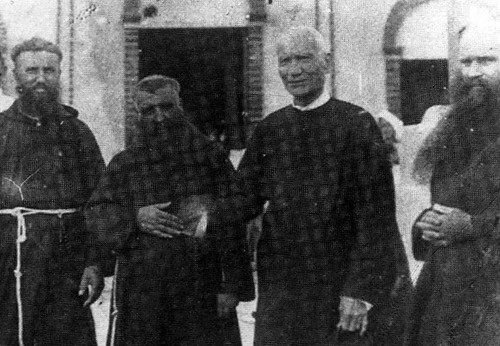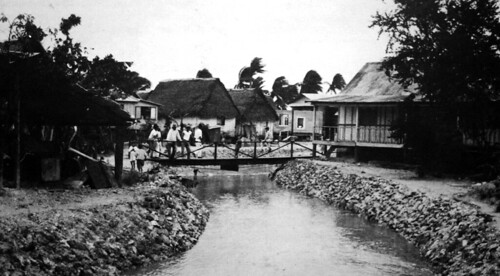Padre Jose Bernardo Palomo
First CHamoru priest
Padre Don Jose Bernardo Palomo y Torres (1836 – 1919) was the first CHamoru priest. He is most often referred to as Father Jose Torres Palomo or Padre Palomo.
Palomo was born 19 October 1836 in Hagåtña to Don Silvestre Inocencio Palomo y Rodriguez, a man of Spanish-CHamoru ancestry, and Dona Rita de Torres, the daughter of Luis de Torres. He was baptized by the village parish priest Padre Don Ciriaco de Espiritu Santo, who was praised for his ministry to numerous natives even while falling sickly.
Palomo’s godfather was Fray Bernardo del Rosario, the superior of the Augustinian Recollect friars. Palomo spent his youth under the tutelage of Augustinians and was particularly influenced by Padre Pedro Leon del Carmen, Palomo’s first teacher and the pastor of Pago village. He later continued his studies under Augustinian superior, Padre Aniceto Ybanez.
In 1856, when Palomo was 20, his parents died during the small pox epidemic along with 5,532 others in Guam. The terrible epidemic, which killed 60 percent of the population in less than one year, convinced Palomo to enter the priesthood.
According to Palomo, the epidemic could have been avoided had a vessel, whose crew had thrown a smallpox victim overboard a day before entering Apra Harbor, been quarantined. Instead, passengers were allowed to disembark, causing the epidemic which Palomo estimated reduced Guam’s population from 9,065 to about 4,000 people.
Small pox epidemic
According to other accounts, Don Silvestre was ill during a trip from the Philippines and may have unknowingly brought the disease to Guam. Both Palomo and Padre Aniceto attended to the sick and dying during the 1856 small pox epidemic that eventually wiped out Pago village where the epidemic had begun.
Shortly after the epidemic, Palomo began his studies for the priesthood at the San Carlos Seminary in Cebu, Philippines where his previous studies in Guam under Padres Del Carmen and Aniceto enabled Palomo to complete his studies at San Carlos within about a year. Palomo was ordained a priest on 11 December 1859 at the private chapel of Bishop Romualdo Jimeno of the Cebu diocese. Bishop Jimeno visited the Mariana Islands six years later, traveling to several Mariana islands in a canoe. The bishop’s visit prompted greater Augustinian attention to Saipan, Tinian, Rota, and the Caroline Islands.
Although first assigned to the village of Hagåtña upon his return to Guam in 1860, Palomo was reassigned to Saipan as a result of this renewed attention. He returned to Guam two years later where he ministered for 16 years after which he was again assigned in 1887 to work on Saipan, Tinian and Rota until 1895. He again served Guam, first at Hågat and then more permanently in Hagåtña.
Influential and respected
Father Palomo’s respected standing among CHamorus in Guam was evident in a complaint by Governor Luís Santos Fontordera (1891-1892) that CHamorus would wait until they had consulted with Palomo before they would respond to and obey official orders from the governor. Palomo was widely regarded as one of the wisest and most educated men in Guam and was fluent not only in Spanish and CHamoru but also in English, French, and Carolinian languages.
Throughout his career he was dedicated to the welfare of the CHamoru people. Although Palomo and other prominent individuals in Hagåtña accepted into their homes several condemned Cavite Mutiny deportees, including 10 Catholic priests, who arrived from Manila in 1872, Palomo considered most of the hundreds of other deportees who followed to be:
the very scum of Spain, 90 percent of whom could neither read nor write . . . wretches who only were good to corrupt the morals of the natives.
And during a convoluted episode in 1872 regarding contradictory stories about an alleged desire of Rota residents to relocate to Humåtak village in Guam following a typhoon, those opposing the move delivered a letter in the CHamoru language to Palomo. The letter sidestepped Spanish authorities and placed the trusted Palomo into the role of an intermediary. Because of the apparent economic motivations of one individual and various other issues, the move never took place.
On 20 and 21 June 1898, US Captain Henry Glass of the USS Charleston seized Guam on his way to reinforce the American Navy in the Philippines during the Spanish-American War. At the time, no one in Guam was aware that Spain and the United States were at war. When the Charleston’s canons fired upon the abandoned Santa Cruz fort in Piti, Spanish authorities took it to be a salute and quickly ordered a canon to be brought from Hagåtña to Piti in order to return the salute.
Meanwhile, Palomo and a few other men went out to the Charleston in a boat owned by naturalized American citizen Frank Portusach and were the first in Guam to learn about the Spanish-American War. Portusach would soon be recognized and vigorously supported by Palomo and several other prominent CHamorus in Hagåtña as the legitimate acting governor of Guam, instead of the only Spanish official who remained after Glass’ departure, Treasurer Jose Sisto who claimed the title and soon drained the island’s treasury.
Although declarations of who was Guam’s legitimate acting governor until the first official American governor arrived changed with the interventions of passing Naval officers, Palomo’s important role in local politics was evident. It was at Palomo’s residence that Palomo and several other CHamoru leaders rejected and dismissed Sisto from office and named Venancio Robert as the governor of Guam.
The intervening arrival of various Naval officers led to more changes in leadership. Lieutenant Vincendon L. Cottman reappointed Sisto and then left while Commander Edward D. Taussig arrived shortly afterwards and appointed Hagåtña gobernadorcillo (mayor) Joaquin Perez as acting governor. Palomo helped to initiate an elected senate in July 1899 consisting of himself, Juan Torres, an American named Romberg and a lower house with six CHamorus.
By that time another American naval commander, Lieutenant Louis A. Kaiser had replaced Perez following a disagreement over Spanish ordinances left in Guam with part-Samoan William Coe. Coe was supportive of this initiative toward self-governance although this effort was thwarted with the arrival on 7 August 1899 of Captain Richard P. Leary, the first of many naval governors of Guam.
Fostered understanding
When the Americans assumed control of Guam after the Spanish American War in 1899, the first Naval governor of Guam, Richard P. Leary, asked the Spanish priests on the island to leave. Lieutenant Cottman had already considered Father Palomo and the Spanish priests to be the moral lepers and recommended that Palomo be sent to another island. Leary however allowed Palomo to remain in Guam. As the Recollect Friars prepared for their departure from Guam, Fray Francisco Resano del Corazón de Jesús, a man who made a great contribution to the Spanish mission in the Marianas, passed on the spiritual administration of the Hagåtña parish to Palomo.
Leary proposed to Palomo that he should found a schismatic church in Guam, independent of Rome. Leary offered to help Palomo even saying the American government would pay him a pension and grant him all the privileges of the officials of the Naval station for cooperating. Palomo indignantly refused.
Palomo became friends with Leary’s aide Lt. William Edwin Safford, furthering American understanding of the CHamoru people and history of the island. Safford functioned as the lieutenant governor of Guam during and after Leary’s three month long stay onboard his ship as the governor’s palace was fixed and refurbished. Safford was fluent in Spanish and quickly integrated himself into the CHamoru community, learning the CHamoru language and becoming friends with Father Palomo, Juan Torres, and others.
While Safford was also burdened with numerous administrative tasks, he also held what were probably the first English classes in Guam in the evenings from his home and, with the assistance of Palomo, wrote a CHamoru grammar and compilation of CHamoru words. Palomo also gave Safford a vocabulary list compiled many years previously by a priest on Rota that included indigenous terms not found in later vocabularies.
Safford also noted in his compilation first published in the American Anthropologist that both Palomo and another contributor to the grammar, Juan de Torres, were decedents of Luis de Torres who was an important source of information in Guam and the other Mariana islands to European explorers Otto von Kotzebue, Louis de Freycinet, and others in the early nineteenth century.
Named Papal Chamberlain
In 1909, St. Pius X named Padre Palomo the first CHamoru priest to hold the title of Papal Chamberlain, with the title of Very Rev. Monsignor, on the occasion of the his Golden Jubilee in the priesthood. This honor was conferred in recognition of the superhuman effort he made to preserve the faith in the island at the beginning of the century.
And while administrative tactics during the early US administration in Guam that were more rigid than those employed by the Spanish resulted in social tension, Palomo was instrumental in easing these tensions. Although these American Naval governors did not consider the CHamorus capable of governing themselves, they nevertheless called upon the advice of several CHamoru elders, particularly Palomo who was looked upon as a key representative of the people’s voice.
Palomo’s Catholic ministry continued throughout Guam, Saipan, Tinian, and Rota. He died after a massive heart attack on 3 July 1919. Father Palomo was 82.
A park is named in his honor along the beach in Hagåtña, next to the Naval Cemetery.
By Audreya JP Taitano, MA and Shannon J. Murphy
For further reading
Driver, Marjorie G., trans. The Augustinian Recollect Friars in the Mariana Islands 1769-1908. MARC Educational Series no. 24. Mangilao: Richard F. Taitano Micronesian Area Research Center, University of Guam, 2000.
Safford, William E. The Chamorro Language of Guam: A Grammar of the Idiom Spoken by the Inhabitants of the Marianne, or Ladrones, Islands. Reprinted from the American Anthropologist, 1903-1905. Washington, DC: W. H. Lowdermilk & Co., 1909.
Sullivan, Julius, OFM Cap. The Phoenix Rises: A Mission History of Guam. New York: Seraphic Mass Association, 1957.
Thompson, Laura M. Guam and Its People. With a Village Journal by Jesus C. Barcinas. 3rd ed. New Jersey: Princeton University Press, 1947.



